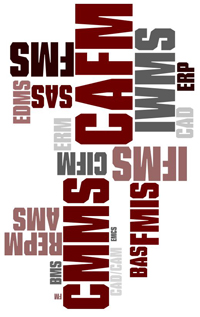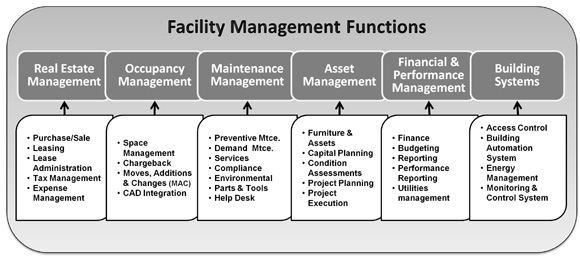 I’m getting more and more frustrated with the acronyms in use in our industry to deal with Facility Management computerized systems. Yes, I you read that right. I used a non-acronym to describe the other acronyms, and you know what, you probably knew exactly what I meant.
I’m getting more and more frustrated with the acronyms in use in our industry to deal with Facility Management computerized systems. Yes, I you read that right. I used a non-acronym to describe the other acronyms, and you know what, you probably knew exactly what I meant.
How about simply using a general yet descriptive term “FM systems” when we are talking about computer systems used in FM. No, I don’t mean the one from that company with the same name, I mean it in the truly generic sense: computerized systems that support FM functions. What else could be easier?
The reality is that there are a broad range of FM systems, admittedly even with 3 letter acronyms, such as the new one called BIM. The other 3-letter acronym is the ever present ERP (Enterprise Resource Planning) system that is essentially a company’s financial system (SAP and JDEdwards/PeopleSoft are prime examples) that may have Facility Management modules bolted on.
And yes, even I sometimes use CAFM when I also mean other functions beyond space management, or talk CMMS and assume it includes other functionality and sometimes I even use IWMS. We all like acronyms, don’t we? When I was a newly minted employee in the facility department at a large telecommunications company, I was involved in compiling the acronyms our company used so we could have a reference tool to decipher them. The list was very, very long.
Now, I try hard to skip the acronyms and call any computerized system that supports Facilities functions an ‘FM system’ whenever I can and broaden it based on context. I can’t do it all the time, however, because we do have to communicate and there is a strong link to the existing acronyms. But I try.
The evolution of the acronyms seems to be from a few branches, such as the term Computer Aided Facility Management (CAFM) systems based on or linked to Computer Aided Design (CAD) systems used for space layouts. Even though the term (CAFM) could apply to many different functional requirements in the Facility Management profession, it is most closely associated with space management and some so-called CAFM systems specialize in space management with little other functionality while others cover a wide range of functionality.
And there are many other functions buried within the acronyms we currently use, yet we don’t always know for sure that they are covered. You won’t know whether it deals with key management, board room booking, managing moves, help desk or other more specific functions unless you open the hood and take a look at the wiring.
Even CMMS, one of the old standby acronyms is a problem. Does it simply manage maintenance tasks, or does it include an asset function, help desk function, etc. Is it used for preventive maintenance only, or for all service requests, including move requests?
The other reason for some of the more recent acronyms and their evolution is the integration of systems, resulting in acronyms with an ‘I’ in them such as the popular Integrated Workplace Management Systems (IWMS), Integrated Facility Management Systems (IFMS) or Computer Integrated Facility Management (CIFM).
While integration is an ideal and the right solution for some companies, the reality is that you may not need integration (it comes with its own problems), your size means it would be overkill or you simply don’t have the full scope under your FM Department responsibility and therefore don’t need all the capabilities of a fully integrated system. The issue is that not all FM systems are (or need to be) integrated, so even IWMS and IFMS can’t be used as the umbrella acronym – it presumes a specific solution. If you want to talk about an Integrated FM system, simply say so.
Here is a graphic from my book”Managing Facilities & Real Estate” that describes common FM systems functionality without using acronyms:

This evolution of terms has caused some challenges as it blurs the terms and makes it more difficult to focus on the functionality of the specific piece of software and the related FM processes. On top of that, there are differences in the acronyms used in different parts of the world. As we converge with the management of global portfolios and become a more global profession, it would be a good idea to straighten this out.
For emerging countries developing their professional capabilities in Facility Management, they have an opportunity to influence the future of FM. Those of us in ‘old school’ markets need to transition to terminology that’s more generic, clearer and user friendly – and let the details explain what we mean instead of always using a four letter word.






The only thing more ridiculous than sheer volume of systems available today, is the acronyms used to describe them all. We struggled with this very same thing when re-branding our product and almost created a new acronym, RMS (Retail Management Solutions). Thankfully, we decided to just spell it out!